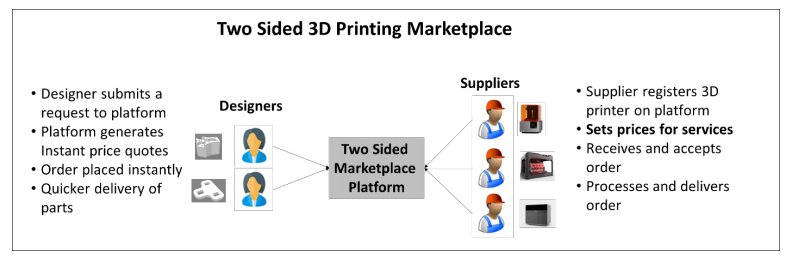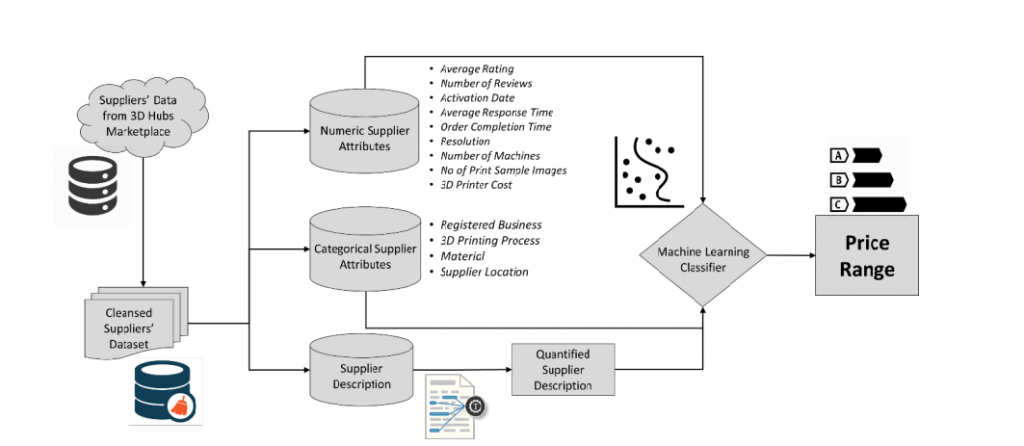Deepak Pahwa and Binil Starly provide cost analytics for 3D printing services bureaus in their recently published paper, ‘Network Based Pricing for 3D Printing Services in Two-Sided Manufacturing-as-a-Service Marketplace.’ Taking a different approach from ‘ad-hoc and subjective’ pricing, the authors suggest a more formulaic route, in using machine learning methods to arrive at prices for clients.
In their new pricing model, the following would be considered in setting rates:
- Supplier experience
- Supplier capabilities
- Customer reviews and ratings
- Scale of operations
Today, most service bureaus arrive at a price after calculating their obvious costs, like what materials are to be used in making a prototype or part, and the amount of energy and labor to be expended in the process. Obviously, profit needs to be figured in too for most companies. Some may factor in higher annual overhead costs, higher costs for the machinery they have invested in, along with issues like pre- and post-processing.
Sharing economical vision with other progressive companies like Airbnb, the authors suggest the idea of a ‘data mining tool’ that tabulates a list of details to better predict price ranges, bring in clients, and make the potential of sales more likely. These are obvious recipes for success, judging by the popularity of such companies who also filter the work and much of the profit to private individuals, or in the case of 3D printing, users.
“Sharing Economy platforms in additive manufacturing industry can benefit by adopting data driven approaches to support suppliers with price prediction,” state the authors.
The authors went to one of the best industry sources, ‘scraping data’ from public profiles of service bureaus at 3D Hubs—an enormous an continually growing organization that helps 3D printing bureaus of all sizes around the world thrive. The researchers found 29,544 suppliers listed, but after ‘cleaning’ their data, a more concise 546 suppliers with 5,469 service listings located in the United States and 1,043 suppliers with 9,808 service listings in Europe.
“Every supplier has a supplier profile which provides information about its service listings and its reputation on the marketplace. A service listing is a unique combination of a 3D printer, material, resolution and a corresponding price,” stated the researchers.
While 346 unique types were listed in detail, they were categorized by:
- Acrylonitrile Butadiene Styrene (ABS)
- Polylactic Acid (PLA)
- Specialty ABS
- Specialty PLA
- Polyethylene Terephthalate (PET)
- Specialty PET
- Polycarbonate (PC)
- Specialty PC
- Nylon, Specialty Nylon
- Flexible Material (Thermoplastic Elastomer/ Polyurethane)
- Acrylonitrile Styrene Acrylate (ASA)
- Metals
- Resins
- Soluble Material (High Impact Polystyrene, Polyvinyl Alcohol)
- Others
Parameters for 3D printers included how much it cost to purchase the 3D printer, and what type of process was involved in making the product, with the following categories:
- Fused Deposition Modelling (FDM)
- Stereolithography (SLA)
- Laser Sintering (Selective Laser Sintering for polymers and Direct Metal Laser Sintering for Metals)
- Jetting (Material and Binder Jetting)
The authors used GPS coordinates for suppliers, using a clustering algorithm to study their data, with 528 different 3D printers identified, and 100 suppliers selected randomly for the research. Details such as key words, reviews from customers, and their actual abilities to provide services were plugged in to analyze price ranges for suppliers.
“These marketplaces generate large amount of data which can be used to understand the participants and provide additional value to them. Historical sales data from a manufacturing marketplace could be used to determine the probability of winning an order at a specific price. In addition to supplier’s features, order attributes such as 3D design, its due date and designer’s attributes such as future potential of orders from the designer can also be considered for price prediction,” concluded the researchers.
“Impact of additional parameters such as demand forecast, seasonal variation and raw material prices can be added to the model to make it more robust.”
The ability to go to a service bureau is an effective way for users to put their concepts into reality without having to put capital into software, hardware, and materials whether they are using them for electronics, working to connect with other professionals too, or working with more industrial materials like metal. What do you think of this news? Let us know your thoughts! Join the discussion of this and other 3D printing topics at 3DPrintBoard.com.
[Source / Images: ‘Network Based Pricing for 3D Printing Services in Two-Sided Manufacturing-as-a-Service Marketplace’]
The post 3D Printing Service Bureaus: Refining Pricing Systems with More Progressive Cost Analytics appeared first on 3DPrint.com | The Voice of 3D Printing / Additive Manufacturing.




35 Replies to “3D Printing Service Bureaus: Refining Pricing Systems with More Progressive Cost Analytics”
Comments are closed.